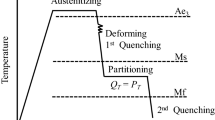Abstract
In order to study the effect of austenitizing temperature and packing time on phase evolution more accurate, a coupling element finite model of hot stamping process of BR1500HS is established based on the platform of DEFORM-3D, which takes the interaction of heat, plastic work, and phase transformation into consideration. The simulated results reveal that the final microstructure mainly consists of martensite, and the martensite volume fraction increases at an austenitizing temperature range from 800 to 900 °C and has a little change with the increasing packing time. Subsequently, a series of physical experiments are conducted to evaluate the reliability of the simulated results. The micrographs show that influence of the austenitizing temperature and packing time on martensite volume fraction is consistent with the simulated results. Further, the tested hardness distribution also proved that the present thermal-mechanical phase coupling element finite model is an effective tool to predict the microstructure during the hot stamping process.
Similar content being viewed by others
References
Merklein M, Lechler J, Geiger M (2006) Characterisation of the flow properties of the quenchenable ultra high strength steel 22MnB5. CIRP Annals-Manuf Technol 55(1):229–232
Staeves J, Pfestorf M (2003) Einsatz höherfester Stähleim Automobilbau. In: Groche P (ed) 8.Umformtechnisches Kolloquium Darmstadt Darmstadt, Germany., http://www.staeves.de/veroeffentlichung/UKD_2003PPT.pdf
Marron G, Teracher P (1996) The application of high-strength, hot-rolled steels in auto wheels. JOM 48(7):16–20
Xing ZW, Cui JJ, Liu HS, Li CF (2010) Numerical and experimental investigation into hot stamping of high strength steel sheet for auto B pillar reinforced panel. Materials and Manufacturing Technology 129–131:322–327
Guo YQ, Yang X, Han JJ, Chen W, Meng Z (2012) Research about warm-hot forming process control of LTVVB auto B-pillar. Advanced Manufacturing Technology PTS-1-4 472-475:3078–3082
Merklein M, Lechler J, Geiger M (2006) Hot stamping of ultra high strength steels as a key technology for lightweight construction. CIRP Annals-Manuf Technol 55(1):229–232
Liu HS, Xing ZW, Lei CX (2012) Hot formation quality of high strength steel br1500hs for hot stamping without cooling system. T Nonferr Metal Soc 22:542–547
Liu HS, Lei CX, Xing ZW (2013) Cooling system of hot stamping of quenchable steel BR1500HS: optimization and manufacturing methods. INT J Adv Manuf Tech 69(1-4):211–223
Liu HS, Liu W, Bao J (2011) Numerical and experimental investigation into hot forming of ultra high strength steel sheet. J Mater Eng Perform 20(1):1–10
Masayoshi S, Jun M, Kazuhisa K, Masahiro O, and Toshihiro M (2003) Properties of aluminized steels for hot forming…\properties of aluminized steels for hot-forming.html
Mori K, Maki S, Tanaka Y (2005) Warm and hot stamping of ultra high strength steel sheets using resistance heating. CIRP Annals-Manuf Technol 54(1):209–212
Bok HH, Lee MG, Pavlina EJ (2011) Comparative study of the prediction of microstructure and mechanical properties for a hot-stamped B-pillar reinforcing part. Int J Mech Sci 53(9):744–752
Ghosh A, Kikuchi N (1998) Finite element formulation for the simulation of hot sheet metal forming processes. Int J Eng Sci 26(2):143–161
Tekkaya AE, Karbasian H, Homberg W, Kleiner M (2007) Thermo-mechanical coupled simulation of hot stamping components for process design. Prod Eng Res Devel 1(1):85–89
Xing ZW, Bao J, Yang YY (2009) Numerical simulation of hot stamping of quenchable boron steel. Mater Sci Eng, A 499(1-2):28–31
Ge PQ, Zhang Q, Zhang L, Zhang JH (2009) Prediction of the residual stress in grind-hardening with thermal-mechanical-phase transformation stress coupled analysis. Mater Sci Forum 626–627:345–350
Liu HS, Xing ZW, Bao J, Song BY (2010) Investigation of the hot-stamping process for advanced high-strength steel sheet by numerical simulation. J Mater Eng Perform 19(3):325–334
Oldenburg M, Åkerström P, Bergman G (2008) Simulation of the microstructure evolution in a press hardened component., http://pure.ltu.se/portal/en/publications/simulation-of-the-micro-structure-evolution-in-a-press-hardened-component(0420f7a0-bd47-11dd-a7c4-000ea68e967b).html
Bariani PF, Bruschi S, Ghiotti A, Turetta A (2006) Testing formability in the hot stamping of HSS. CIRP Annals-Manuf Technol 57(1):256–268
Mori K, Maki S, Tanaka Y (2005) Warm and hot stamping of ultra high tensile strength steel sheets using resistance heating. CIRP Annals-manufacturing Technology 54(1):209–212
Author information
Authors and Affiliations
Corresponding author
Rights and permissions
About this article
Cite this article
Quan, Gz., Wang, T. & Zhang, L. Research on the influence of hot stamping process parameters on phase field evolution by thermal-mechanical phase coupling finite element. Int J Adv Manuf Technol 89, 145–161 (2017). https://doi.org/10.1007/s00170-016-9058-6
Received:
Accepted:
Published:
Issue Date:
DOI: https://doi.org/10.1007/s00170-016-9058-6




